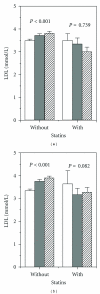Cholesterol, C-Reactive Protein, and Periodontitis: HMG-CoA-Reductase Inhibitors (Statins) as Effect Modifiers
- PMID: 22203908
- PMCID: PMC3235692
- DOI: 10.5402/2011/125168
Cholesterol, C-Reactive Protein, and Periodontitis: HMG-CoA-Reductase Inhibitors (Statins) as Effect Modifiers
Abstract
Common risk factors of periodontitis and cardiovascular diseases fuel the debate on interrelationships between them. The aim is to prove whether statins may influence periodontal parameters by affecting either of these factors. Out of the 4,290 subjects of SHIP (Study of Health in Pomerania), we included subjects aged >30 years (219 with statins, 2937 without) and excluded edentulous. We determined periodontal measures, cholesterol fractions, and inflammation markers. Statin use and periodontal risk factors were assessed. Gingival plaque and periodontal attachment loss were associated with systemic LDL cholesterol (P < 0.001) and C-reactive protein CRP (P = 0.019) revealing interaction with statin use. When adjusted for age, sex, smoking, diabetes, education, and dental service, statins were identified as effect modifiers abolishing the relationship between attachment loss and LDL and between gingival plaque and LDL (interactions P < 0.001). No statin-related interaction was detected with increase in CRP. The interaction supports the view of inter-relationships between periodontal and systemic inflammatory mediators.
Figures


Similar articles
-
Tooth loss, periodontitis, and statins in a population-based follow-up study.J Periodontol. 2014 Jun;85(6):e160-8. doi: 10.1902/jop.2013.130456. Epub 2013 Dec 5. J Periodontol. 2014. PMID: 24304227
-
Periodontal status and hyperlipidemia: statin users versus non-users.J Periodontol. 2013 Jan;84(1):3-12. doi: 10.1902/jop.2012.110756. Epub 2012 Apr 2. J Periodontol. 2013. PMID: 22468682
-
C-reactive protein as a systemic marker of inflammation in periodontitis.Eur J Clin Microbiol Infect Dis. 2011 Mar;30(3):407-14. doi: 10.1007/s10096-010-1101-1. Epub 2010 Nov 6. Eur J Clin Microbiol Infect Dis. 2011. PMID: 21057970
-
Pharmacodynamics and pharmacokinetics of the HMG-CoA reductase inhibitors. Similarities and differences.Clin Pharmacokinet. 1997 May;32(5):403-25. doi: 10.2165/00003088-199732050-00005. Clin Pharmacokinet. 1997. PMID: 9160173 Review.
-
Justification for the Use of Statins in Primary Prevention: an Intervention Trial Evaluating Rosuvastatin (JUPITER)--can C-reactive protein be used to target statin therapy in primary prevention?Am J Cardiol. 2006 Jan 16;97(2A):33A-41A. doi: 10.1016/j.amjcard.2005.11.014. Epub 2005 Dec 1. Am J Cardiol. 2006. PMID: 16442935 Review.
Cited by
-
Effect of topical simvastatin (1.2 mg) on gingival crevicular fluid interleukin-6, interleukin-8 and interleukin-10 levels in chronic periodontitis - A clinicobiochemical study.J Oral Biol Craniofac Res. 2016 May-Aug;6(2):85-92. doi: 10.1016/j.jobcr.2015.11.003. Epub 2015 Dec 5. J Oral Biol Craniofac Res. 2016. PMID: 27195204 Free PMC article.
-
Evaluation of anti-inflammatory effect of statins in chronic periodontitis.Indian J Pharmacol. 2013 Jul-Aug;45(4):391-4. doi: 10.4103/0253-7613.115017. Indian J Pharmacol. 2013. PMID: 24014917 Free PMC article. Clinical Trial.
-
High-dose atorvastatin reduces periodontal inflammation: a novel pleiotropic effect of statins.J Am Coll Cardiol. 2013 Dec 24;62(25):2382-2391. doi: 10.1016/j.jacc.2013.08.1627. Epub 2013 Sep 24. J Am Coll Cardiol. 2013. PMID: 24070911 Free PMC article. Clinical Trial.
-
Role of ketogenic diet and its effect on the periodontium. A scoping review.Front Oral Health. 2024 Feb 1;5:1364578. doi: 10.3389/froh.2024.1364578. eCollection 2024. Front Oral Health. 2024. PMID: 38361577 Free PMC article.
-
Pleiotropic effects of statins on the treatment of chronic periodontitis--a systematic review.Br J Clin Pharmacol. 2015 Jun;79(6):877-85. doi: 10.1111/bcp.12564. Br J Clin Pharmacol. 2015. PMID: 25444240 Free PMC article.
References
-
- Albandar JM. Global risk factors and risk indicators for periodontal diseases. Periodontology 2000. 2002;29(1):177–206. - PubMed
-
- Al-Zahrani MS, Kayal RA, Bissada NF. Periodontitis and cardiovascular disease: a review of shared risk factors and new findings supporting a causality hypothesis. Quintessence International. 2006;37(1):11–18. - PubMed
-
- Beck JD, Offenbacher S. Relationships among clinical measures of periodontal disease and their associations with systemic markers. Annals of Periodontology. 2002;7(1):79–89. - PubMed
-
- Iacopino AM, Cutler CW. Pathophysiological relationships between periodontitis and systemic disease: recent concepts involving serum lipids. Journal of Periodontology. 2000;71(8):1375–1384. - PubMed
-
- Arnaud C, Veillard NR, Mach F. Cholesterol-independent effects of statins in inflammation, immunomodulation and atherosclerosis. Current Drug Targets. Cardiovascular and Haematological Disorders. 2005;5(2):127–134. - PubMed
LinkOut - more resources
Full Text Sources
Other Literature Sources
Research Materials
Miscellaneous

